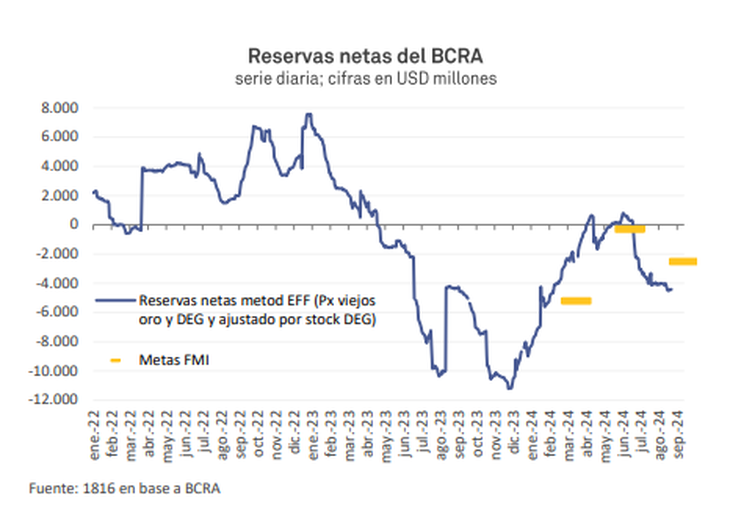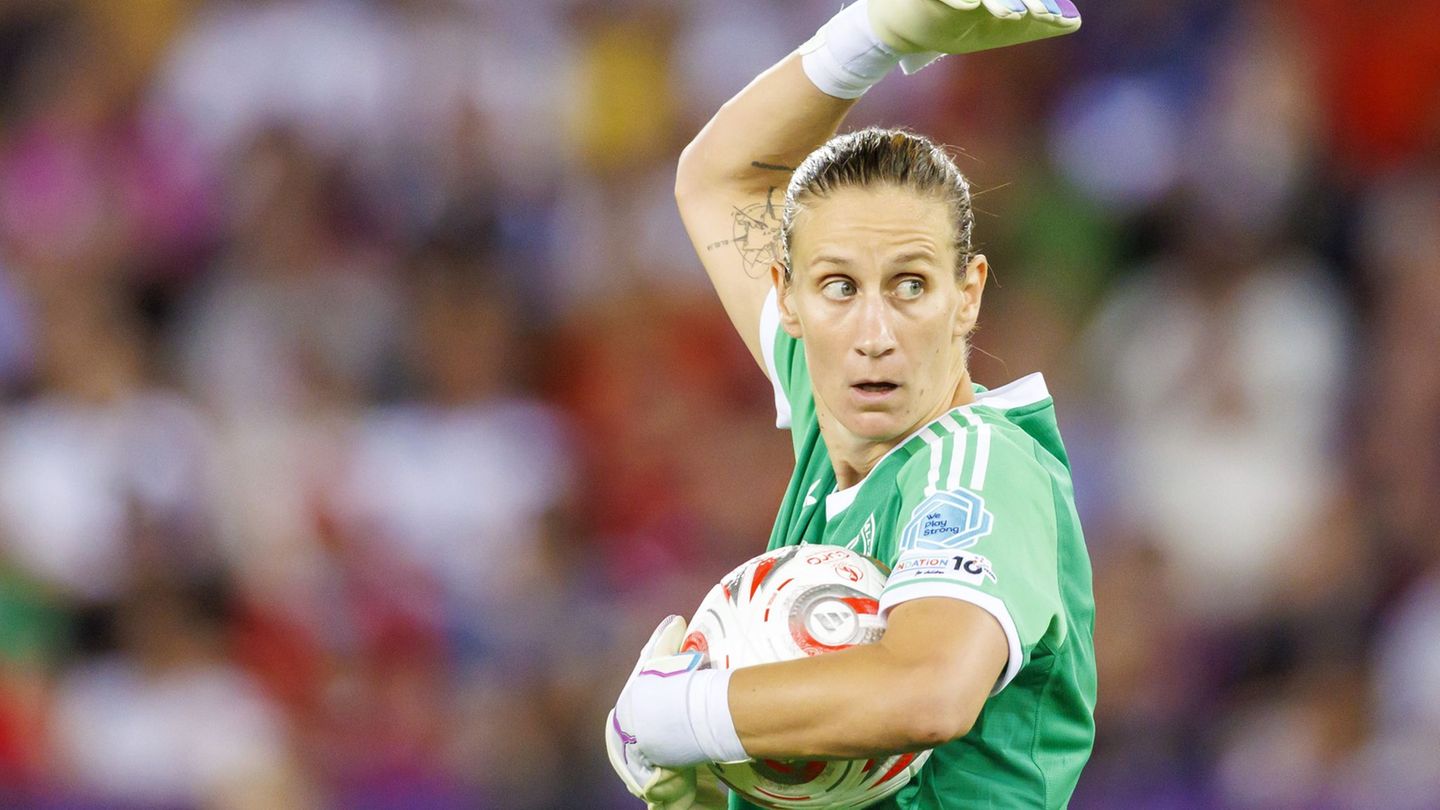The Central Bank had to sell US$74 million on the official exchange market this Thursday and stretched the Accumulated negative balance during September of US$106 million. As told Scopethis month was already proving to be challenging for the coffers of the BCRA after a meager August recovery. But City economists and analysts warn that The greatest pressure on reserves will come in October, when a combination of factors comes together: unfavorable seasonality for the inflow of foreign currency will be added to the peak demand for import payments due to two recent measures by the economic team.
The net reservesaccording to various private estimates, are negative by just over US$5 billionThe prospects for accumulation between now and the end of the year are not encouraging, and therefore the deficit in the BCRA’s coffers is a cause for concern for economic agents.
The Central Bank stopped buying foreign currency towards the end of May, earlier than the seasonality predicted. Then it chained two consecutive months of sales (June and July) and a slight recovery in August. September was again dyed red. But from October onwards the greatest challenge is expected for the maintenance of the exchange rate scheme of Minister Luis Caputo.
Reserves: the factors that will add pressure in October
Seasonally, September, October and November are complicated months in themselves because Foreign exchange earnings from agriculture become more limited once the high season for the liquidation of the coarse harvest is over. On this occasion, the tenth month of the year will have Two additional pressure factors for reserves: the overlap of the new two-installment import payment scheme (launched by the Government in August) with the old four-quota system and purchases abroad that were postponed pending the reversal of the PAIS tax ratewhich has been in force since September. According to analysts, both could have their greatest impact in October.
As this media outlet anticipated, the overlapping of both import payment schemes would mean that, in a theoretical scenario, between September and November the equivalent of an extra month of purchases abroad would have to be paid. For example, In September, the ratio of payments to imports would rise to 125% since the payment of 25% of the merchandise received in May, June and July overlaps with 50% of what was purchased in August. In October, that ratio would rise to 150%.
image.png
Added to this will be the impact of another Government measure: the decision, announced in advance, to roll back the tax rate. COUNTRY TAX from 17.5% to 7.5% (the level it had when Javier Milei took over) starting in September, which made During August many importers will play with that date when it comes to carrying out the different stages of the foreign purchasing process to pay a lower rate.
BAVSA analysts believe that This measure will impact reservations “from October” since the first installment of imports made this month will only be paid after 30 days.
The 1816 consultancy also analyzed this factor. Based on the sales trend of the BCRA so far in September, it considered that the reduction of the PAIS tax did not impact the demand of importers so immediately and agreed that “We may see that effect in early October, when the MULC is accessed (the official market) for 50% of what was imported this month”The firm also noted that, although it is not evident, it is possible that the BCRA’s purchasing balance in August was partly due to speculation regarding the implementation of this measure.
Thus, 1816 stated: “Although importers pay an advance of 95% of the PAIS tax at the time the goods enter Argentina, the real taxable event is not the import, but the purchase of foreign currency. Those who had permission to access the MULC in August were importers who had already paid in advance 95% of the PAIS tax for those transactions, but perhaps they ‘took a chance’ to access the MULC only as of September 1st in order to have the right to eventually collect a refund for having paid a rate that did not correspond”, although for the moment the Government has not regulated any type of refund.
Pressure on reserves, pressure on the Caputo plan
Thus, October is shaping up to be the most tense month for the BCRA’s coffers, while The Government is betting on getting some oxygen with the money launderingwhich will hardly contribute to net reserves but will contribute to gross reserves. The first impact of the regularization of undeclared capital is already reflected in the fact that dollar deposits have grown by more than US$1.6 billion since August 12, although the final result remains to be seen.
“The last quarter is seen as challenging, given the impact of the end of the PAIS tax and the change in the payment format for imports (from four to two installments), which will increase the demand for the official dollar and will put pressure on reserves. To do this, The government will need to receive a ‘bath’ of dollars from the money laundering in order to weather the situation. If not, changes will probably have to be made to the scheme. to rebuild the external front,” he warned Sebastian Menescaldidirector of the consulting firm Eco Go, in conversation with Ámbito.
It happens that Caputo maintains the “go-go” of his exchange rate schemewhich includes the extension of the cepo, the 2% monthly crawling peg and the dollar blend, through which 20% of the liquidation of exports does not go to the reserves but enters through financial dollars. In the City, they consider that the Achilles heel of this strategy is the lack of foreign currency.on the eve of a 2025 with external debt maturities of around US$18 billion.
The government’s bet is based on the fact that its main focus is trying to speed up the deceleration of inflation, which until now has been its main political asset. The CPI rebounded to 4.2% in August (despite the collapse in consumption and the exchange rate anchor) adds complications: not only because of the impact on the population; also because it reinforces the exchange rate appreciation process, which could feed back into the devaluation expectations in the future. And any exchange rate jump would have its counterpart in the overheating of prices.
Meanwhile, as Ámbito reported, compliance with the reserve accumulation target net agreed with the International Monetary Fund for the third quarter it entered the risk zoneTo meet this goal, the BCRA would need to raise around US$2 billion by the end of the month, which seems very difficult.
image.png

The mid-year goals (in fiscal, monetary and reserve matters) had been over-fulfilled, something that was highlighted this Thursday by the IMF spokesperson, Julie Kozack, in the same press conference in which she confirmed the postponement of the negotiations with Argentina by Rodrigo Valdés, the director for the Western Hemisphere who had been questioned by Javier Milei. These are the goals that the Fund’s technicians will evaluate in the ninth audit of the current program, on which the next disbursement of US$531 million depends. For this reason, 1816 considered that this review “is little more than a formality.”
But the outlook will be different in the next review, initially scheduled for November, in which the Fund will review the commitments of the third quarter and on which the last disbursement of around US$550 million will depend. These are the shipments agreed in 2022 by the Government of Alberto Fernández to refinance the US$45,000 million that Mauricio Macri took in 2018. For that audit, some analysts They are already anticipating a possible waiver request due to a possible failure to meet the reserve target. “A waiver is not denied to anyone,” 1816 clarified in its latest report.
Source: Ambito
I am an author and journalist who has worked in the entertainment industry for over a decade. I currently work as a news editor at a major news website, and my focus is on covering the latest trends in entertainment. I also write occasional pieces for other outlets, and have authored two books about the entertainment industry.




